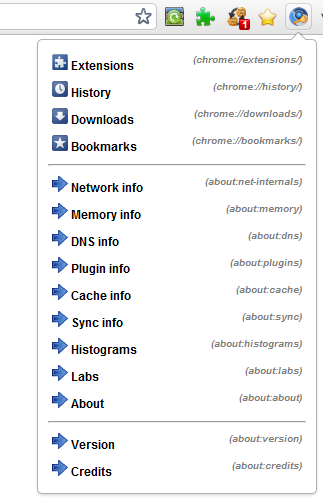Google Chrome offers a vast amount of information and statistics about the browser through its numerous ‘about’ pages. There is no link on Chrome’s interface to access these pages directly. The only way to get to these pages is by typing in the URL in the address bar, until now.
Chrome Access is an extension for the browser that reduces all the typing into a two-click affair. The extension adds a new button on the toolbar clicking which reveals a menu.

The pages that you can access include:
- 'about:net-internals' - overview of network status and usage
- 'about:memory' - an overview of chrome memory usage, by tab and in total. It will also give data for other browsers if they are open.
- 'about:dns' - lists stored dns data.
- 'about:plugin' - lists all the plugins that chrome is using (such as Flash or QuickTime).
- 'about:cache' – lists all the items in the browser cache.
- 'about:sync' - gives bookmark sync data.
- 'about:histograms' - gives low-level performance data
- 'about:version' - gives a detailed version page with the Chromium, WebKit and V8 builds currently being used and user agent info.
- 'about:credits' - lists the (open-source) software and API's that Chrome uses and links to their respective websites.
- 'about:about' - lists all of chrome's about pages.
- 'about:labs' – lets you to enable/disable experimental features.
As a bonus it also provides links to the 'chrome://' pages which are Extensions, Downloads, Bookmarks and History).

Thanks for the nice information.This will help a lot of users.
ReplyDelete